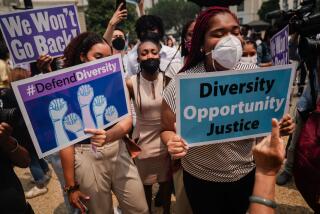PERSPECTIVE ON AFFIRMATIVE ACTION : Race Matters Most
- Share via
Proposals to base affirmative action on economic class rather than race ignore fundamental truths about the interplay of race and class.
Part of the rationale for class-based affirmative action is that social policy should aid those most disadvantaged; with the civil rights revolution behind us, if there is any American hierarchy, it is built on economics rather than race. The thinking is remarkably straightforward: People should be helped because they’re poor, not because they’re black or Mexican American. But, the argument continues, class-based affirmative action would largely help black Americans and other minorities, because they are disproportionately low-income. This approach keeps the government out of the distasteful business of racial preferences and avoids the imagery that most arouses hostility toward affirmative action: an affluent black obtaining a benefit at the expense of a working-class white. Eliminating the racial designation is thus seen as a way of maintaining affirmative action’s political support and continuing to help racial minorities.
Unfortunately, equating disadvantage with economic status obscures the importance of race. The social and economic isolation of black Americans means that they would benefit hardly at all from such a program. Being black and poor is not the same as being white and poor. Low-income whites would most benefit from class-based affirmative action for the same reason that middle-class, educated blacks most benefit from race-based affirmative action: The social, educational and cultural advantages of living in a stable middle-class community boost one’s achievement, even, in the case of poor whites, if one’s own family is not middle-class.
Race is not simply correlated with economic status; race contributes to economic status, reinforcing either mobility or stagnation. Most poor blacks live in the wastelands of our urban areas, more marginal and isolated than ever, the advent of integration having freed their middle-class brethren from the ghetto. Poor whites, in contrast, are much more likely to live in socioeconomically integrated communities and benefit from the improved schools, health services, recreational facilities and safety. Appalachia notwithstanding, there are no white Detroits or Comptons.
The different environmental influences of whites and blacks are reflected in the test scores and other measures of achievement upon which affirmative action selections typically are based. Just as affluent blacks outperform poor blacks and thus capture a disproportionate amount of affirmative action benefits, so would poor whites. The benefits of middle-class social environments cause whites to consistently outperform blacks of comparable income on widely used measures of achievement.
Our racial divide is stark enough or deep enough (depending on which image you prefer) that those who live in neighborhoods that offer little prospect of achievement are nearly all minority. No matter how poor whites are, they generally live in neighborhoods better than those of poor blacks.
The struggles of those caught in the synergistic bind of race and class find little place in a debate obsessed with the usurped entitlement of victimized whites. If we were serious about helping those most in need, we’d base affirmative action on both race and class.
The idea that simply helping poor people will help black people stems in part from a desire not to confront the depth of our racial difficulties. Poor blacks face a more daunting social terrain than any other group of Americans not because they’re poorer, but because they’re black. This is the most troubling aspect of class-based affirmative action: the mistaken assumption that our racial problem is simply class disadvantage in disguise--the notion that remediating class disparities will dissolve our racial difficulties in the tonic of economic equality.
More to Read
Get the L.A. Times Politics newsletter
Deeply reported insights into legislation, politics and policy from Sacramento, Washington and beyond. In your inbox twice per week.
You may occasionally receive promotional content from the Los Angeles Times.










